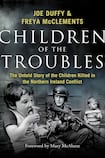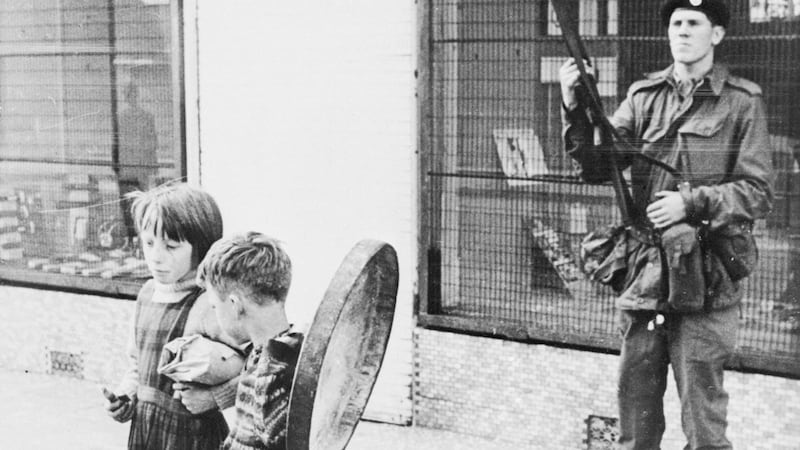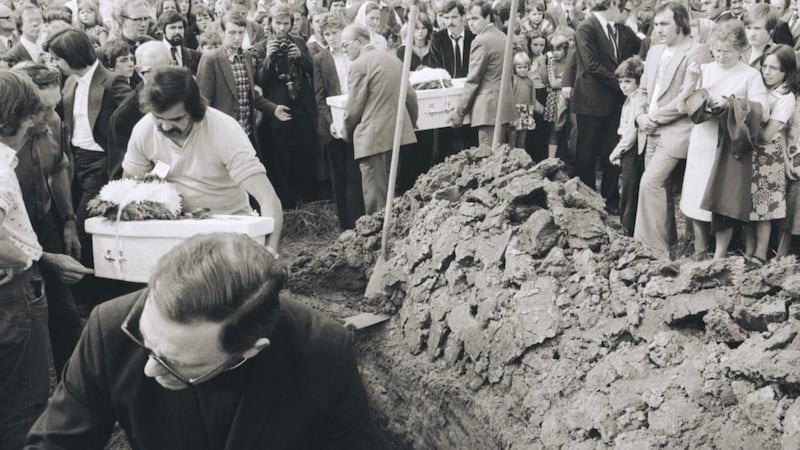
The Troubles began before 1969. In 1966, the UVF deliberately killed two young Catholics, storeman John Scullion and barman Peter Ward, and members of the same organisation also accidently killed an elderly Protestant widow, Matilda Gould, when they firebombed her home; they had mistaken it for a Catholic-owned public house. Part of the “forelash” against the civil rights movement, those killings open Lost Lives, the most reliable reckoning of the Troubles’ death toll.
And yet it was in 1969 that it became clear that the Troubles had begun, that nothing thereafter would be the same. It was in 1969 that the fiction that Northern Ireland was a liberal democracy was torn to shreds on television – at Burntollet, in the Bogside and on Bombay Street. It was in August of that year that the British army was deployed in the North. And it was in December that the Provisional IRA emerged from a split in republicanism.
The IRA ceasefire of 1994 marked the public beginning of the protracted end. And 1994 is as distant from the present moment as it was then from 1969. People born in 1969, who are still with us, were 25 in 1994 and they are now 50. They are the literal “Children of ’69”, but that moniker was first applied to kids who, in that year, became wide-eyed witnesses to destruction and death and, whether nationalist or unionist, started to apprehend their place in Stormont’s hierarchy of disdain and regard.
Children of the Troubles, by broadcaster Joe Duffy and Northern Correspondent of The Irish Times Freya McClements, concerns the original “Children of ’69”, the literal children of 1969, and children born after 1969 – some born, indeed, in the late 1990s. Specifically, it concerns 186 children – aged 16 and under – who died “as a result of the Troubles”.
Duffy and Clements provide short memoirs of the dead, based on extensive archival research and interviews with family members and friends; the memoirs are deeply moving. There are also six essays, no less moving. The titles are self-explanatory: Childhood of the Troubles; War on the Streets; Families; Rubber and Plastic Bullets; Young Combatants; and Legacy of the Troubles.

Patrick Rooney (9) was the first child to die, shot going to bed on August 15th, 1969, when the RUC machine-gunned Divis Flats. The last child killed was Michael McIlveen (15), beaten to death by loyalists in Ballymena in 2006.
Families burned out
Killed on the same day as Rooney was Gerald McAuley (15), a member of Na Fianna, shot by a loyalist as he helped to evacuate families burned out of Bombay Street. Nicknamed Geraldo, he, who entered this world in 1954, was the first born of the 186 children to die in the Troubles. Were he still living, he would have a pension and a bus pass.
The last born were Breda Devine and Maura Monaghan, their lives extinguished at 20 months in Omagh, by the Real IRA, in August 1998; killed with them were the unborn twin sisters of Maura Monaghan and their mother, Avril. All four girls might now be at college, taking their first steps to independence.
Children of the Troubles grew from Duffy’s investigation of the lives of 40 children killed during the 1916 Rising, which resulted in a successful book and TV documentary. Working on that project, he saw “parallels between the children killed in Easter Week and the children who died in the bloodiest conflict of 20th-century Ireland, the North’s Troubles”.
For sure, there are “parallels”, but the Troubles are more recent, they lasted longer than a week, occurred over a wider area than inner-city Dublin, and the form that political violence took was different. This terrain is more difficult, no route picked over it is not challenging. Most obviously, as Duffy and McClements acknowledge, more problems of definition present themselves. In 1969, James Coleman, Margaret Campbell and her child, James (3), fled south from Belfast as refugees from loyalist violence; these victims of expulsion perished from carbon monoxide poisoning in a caravan in Kildare in early January 1970. Duffy and McClements decided not to recognise the toddler as a casualty of the conflict.
Conversely, they do include Francis McGuigan who died aged 23 months in April 1970. Rampaging through Ballymurphy, the British army fired CS gas into houses. His older sister, Margaret, remembers hearing a window smash and then the gas; she remembers coughing and her eyes streaming and burning. Francis, in his cot, became ill: he was taken to hospital, never to come home. The British army denied the gas caused his death. A state pathologist was “of the opinion that death was not caused by gas”. His family and community groups demanded an inquest. The inquest jury decided that the death was due to natural causes; the coroner ruled that the police and military were in no way responsible. Duffy and McClements “adjudged that the circumstances of his death and his sister’s testimony was [sic] sufficient to merit his inclusion”.
Complex and contested
Nothing here is easy. In the introduction, the authors offer a bald statement about those "responsible" for the 186 deaths: "The majority – approximately 42.5 per cent – were killed by republicans. Loyalists were responsible for 27 per cent of child deaths, and the security forces for 26 per cent". Nowhere is 42.5 per cent a majority. A cold-eyed commentator, alert to what was at issue in the conflict, might fairly say that pro-union forces were responsible for 53 per cent of "child deaths", which is a majority. Moreover, as the memoirs and essays attest, "responsibility" is complex and contested. Some teenagers died in accidents when undergoing arms training. And some of those who loved them ascribe responsibility for their deaths to the political situation in which they took up arms, not to any organisation. In fairness, the introduction is less polished than the carefully crafted memoirs and essays that constitute the body of this book.
Children of the Troubles provides no timeline of deaths, but one finds oneself counting: two children killed in 1969, five in 1970, 15 in 1971, 40 in 1972, the worst year, and on and on, down all the years, out of the last century and into the present.

The early 1970s were terrible. This book runs to 430-odd pages; the reader reaches 1976 on page 205. 1983 and 1984 were the first years after 1969 that no child died in the Troubles; and none died in 1986 or 1987. But children died in every year from 1988 to 1993 and from 1996 to 1998, when 13 died, three in Ballymoney and 10 in Omagh – that was after the Belfast Agreement. And there were two “child deaths” in 2001, one in 2005, and one in 2006.
Maps show where the 186 children died. Conspicuous is Belfast: 106 children, most in the north (41) and west (54) of the city. Most other “child deaths” were elsewhere in the North, including 17 in the city of Derry, 10 in Omagh, four in Newtownabbey, three in Glengormley, three in Ballymoney, and three in Claudy. However, three children died in Dublin, two in Mullaghmore, two in Cavan, two in Warrington, two in Yorkshire, one in London, and one in West Germany.
Statistical clarity
And who were these children? The memoirs repeatedly depict working-class lives, with some older children, particularly in the early 1970s, already lifting a pay-packet: among the victims of the IRA bombing of Claudy were Billy Temple (16), who worked on a bottling machine in Leckpatrick Co-op, and Joe Connolly (15), who was about to start in Desmond’s Clothing Factory.
The authors bring some statistical clarity to their gender, age and community. There is almost no need. The photos are mainly of boys – just over a quarter were girls. Most of the photos are of teenagers: almost two-thirds were in their teens, almost a third aged 16. And if a fallible marker of community, surnames and placenames in a list of the dead tell what the memoirs confirm: the vast majority of children killed in the Troubles belonged to the nationalist minority, commonly estimated for much of this period at less than 40 per cent of the North’s population. According to Duffy and McClements, 80 per cent of the dead children were Catholics.
"Catholic" does not, of course, mean "nationalist", and the percentage can likely be adjusted, very slightly, downwards for "nationalists": for instance, Fernando Blasco Baselga (12), killed at Omagh, was Spanish. Still, that the majority of the dead children belonged to the minority community is clear and no surprise. Best estimates for the total "local" body count in 1969-2001, reviewed and qualified in Brendan O'Leary's A Treatise on Northern Ireland (2019), assign about 55 per cent of the dead to the nationalist bloc. And yet the nationalist proportion of all child fatalities (in the North and elsewhere) remains shocking, most especially when death was concentrated among working-class males in Belfast.
The statistic (80 per cent) is given not in the introduction, which is quick to ascribe “responsibility”, but on page 118. I think that most historians would have acknowledged at the outset that “child deaths” were unevenly distributed in this deeply divided society. But Children of the Troubles is not a history: its stated purpose is not to explain, it is to commemorate. “While their loss”, Duffy and McClements write of the dead, “is always with their parents and siblings, their friends and their communities, all too often their names have been publicly forgotten . . . this is something we have sought to remedy . . . We remember that they lived and were loved, and celebrate them: their characters, their passions, their hopes and dreams. They do count.” The authors hope that they “have done all the children justice”.
Human cost
That is well-meant, but is it meaningful? Some readers – not least, among the bereaved – might well ask: “And what justice can be done them?” No book or TV documentary can provide these dead children with a place in the futures denied them. There were appeals aplenty after 1969, including at the funerals of children remembered here, for people to reflect on the human cost of violence, and to pity and to say “Never again”, that is, to make deaths “count”. And as long as the causes of the conflict were not addressed such appeals were unavailing. It was only in the early 1990s when the British government at length did what it said it would never do (although it had previously done it) and engaged with republicans that the prospect of an end to violent conflict came into view. What point pity and commemoration if we lose sight of the political situation that caused death, and indeed, the forces that now threaten our peace?

Again, nothing here is easy. Duffy and McClements masterfully evoke everyday lives in dark times and they skilfully recover the characters of many of these children. Their memoirs form a mosaic of sorts: the contours, if not the causes, of the conflict emerge, as do its costs and those who bore them.
There are mistakes. For instance, Bernadette McAliskey (not Devlin) was no longer an MP when loyalists shot her and her husband in 1981. Many of the photos in the book, many of which are not familiar, have no captions. Included in a montage of family snaps and actual items dear to the dead – the school satchel of Denise Dickson (5), killed by a British army armoured car in North Belfast, and the teddy bear of Patrick Toner (7), killed by an IRA booby-trap in Forkhill – is a stock photo of a Dinky car collection “like the one that Anthony McDowell treasured”; not being “real”, it strikes a discordant note.
Children of the Troubles cannot have been an easy book to write. In a time when others are indifferent to our tomorrows, its short accounts of lives cut short do linger in the mind. And yes, my phrasing summons the dead for a purpose. We do it all the time. Let us hope that one day we have the fortune and the grace to let the dead rest in peace.
Historian Breandán Mac Suibhne won the inaugural Michel Déon Prize for Non-Fiction for his book The End of Outrage: Post-Famine Adjustment in Rural Ireland












